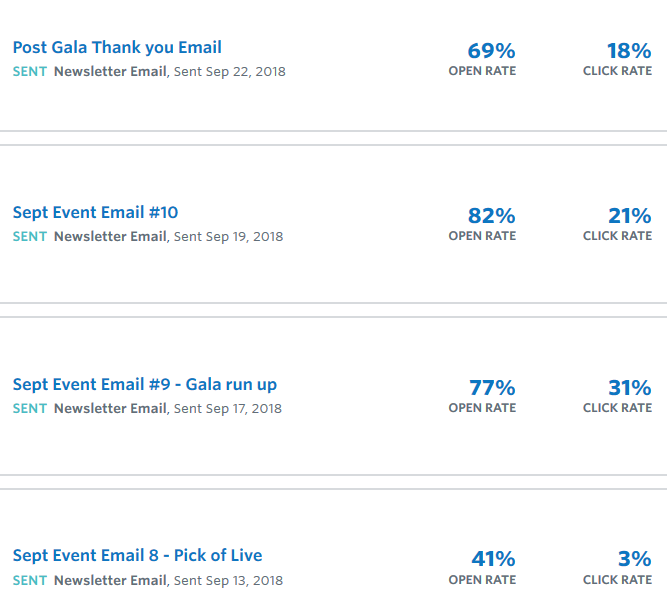8 Clever Ways to Increase Your Nonprofit’s Email Open Rates
How to Beat Typical (and Declining) Industry Open Rates
According to an annual study from M&R Benchmarks, 13% of all online fundraising revenue in 2018 was driven by email.
So the importance of keeping your email open rates as high as possible needs no convincing. The question we must answer is, what can you do to sustain or increase your nonprofit’s open rates?
The Benchmarks study says ‘advocacy’ email open rates dropped to 15% in 2018, and ‘fundraising’ email open rates dropped to 14%. The good news was, unsubscribes were lower, in spite of an increase to an average of 59 emails sent to each subscriber for the year – about 5 per month. This somewhat confirms that sending more emails doesn’t have to mean you’ll get more unsubscribes.
Read surprising truth about how many emails you should be sending
But does sending out more emails lower your open rates? Test it and find out. If so, is that okay as long as revenue stays strong?
How does your nonprofit compare to the numbers in the study?
I have clients with open rates in the high teens, often in the 20s and even over 30%. But I’ve also sent out emails with over 70% open rates, as you’ll see in a bit. How do we get these kinds of numbers?
Here are 8 ways to increase your open rates above the averages in the Benchmarks study.
1. Segment Your Email List
How do we get email open rates like in the screenshot below?

By segmenting.
In this case, these emails were sent only to people planning to attend a fundraising gala, or who did attend it and were sent a personalized thank you email afterward.
You can do the same thing in almost any email campaign. Send something to previous campaign donors. Send only to your recurring donors. Send to anyone who has clicked on an email petition in the past.
The fear here is, what if we’re missing out on engaging someone new on our list who isn’t yet in these segments? The answer to that is simple: Yes, you should also be sending appeals to your general list, and be okay with the lower open rates. But by also sending more personalized emails to smaller segments, you’re doing more than just increasing open rates.
You’re also communicating that you know and value these people. You’re keeping them closer to your nonprofit’s heart, more connected, more engaged.
2. Be Less Predictable
Some nonprofits send out emails quite frequently, and it feels like a continuous stream of content. That’s fine. But it also runs the risk of becoming predictable and routine for your readers. “Another email from [your nonprofit],” they think.
When communication starts to feel routine, and less urgent, the motivation to open your emails declines.
How can you be less predictable?
One way is to space out your emails unevenly. Rather than sending two per week every week on the same two days, maybe try a week with no emails, and then three the next, all related to a similar theme.

Image by James Stevens from Pixabay
And instead of random emails with no linkage, end one on a cliffhanger, and pick it up on the next email. Make people want to see the next email.
We always talk about storytelling in fundraising. Well, stories are more exciting when a chapter ends with the reader on edge, waiting with bated breath for what’s coming next, unable to put the book down. Or TV shows that end on the highest note of suspense, virtually guaranteeing the viewer will be back for the next episode.
You can do that with email too.
3. Change Your Email Sender Name
Changing your sender name is actually just another way to be less predictable, but it’s something you should use strategically.
Some nonprofits and businesses change their sender name frequently, rotating between several different names. I don’t know what kind of data they’re getting, but I think continuously sending from new names runs the risk of looking like spam. The busy reader sees an unknown name and wonders if it’s legit.
On the other hand, if your nonprofit uses the same name in almost every email, try changing it up. By selectively sending certain emails from a different person – and doing so for a reason that’s made clear in the email and possibly also the subject line – now you’re making the reader think something important has happened. This aligns with the ‘breaking news’ concept, that “we’re interrupting this broadcast with an important message.”
Breaking routine gets attention.
So if all your emails come from your Executive Director, try sending one from the volunteer coordinator, or the CEO, or the founder. If they’re all from the founder, send one from a new intern who just came on board.
See some powerful data and more insights on changing sender names.
4. Get People to Add Your Email to Their Contact List
You’ve got to stay out of the spam and promotions folders. Those are the death knell for email open rates.
In your email welcome series, make it a priority for people to add you to their contact list. Put this request in every email in the series. That’s your best opportunity for doing this.
But there’s also no harm at all in sending out a fresh plea to your main list to do the same. Too often, we underestimate the value in taking small steps like this.
Suppose you have 3000 names in your email list, and you send an email appeal with the sole purpose of asking them to add you to their contact lists. If only 30 people do it, was that a waste of an email?
No!
That’s 30 people who now shouldn’t ever miss an email for the trite and tragic reason that it got diverted away from their main inbox because of an algorithm. That’s a win.
5. Purge Inactive Email Subscribers
This goes along with segmenting. You can create segments that still include large portions of your list simply by weeding out anyone who hasn’t opened an email in, say, over two years.
Then, send the majority of your future emails only to that segment.
If your total list has 5000 names, but only 3500 of them have opened even one email in the last two years, you’ve just ‘removed’ 1500 non-openers.
Suppose you have 500 people opening your typical emails. Well, guess what?
You just increased your open rate from 10% to 14%.
But, you might ask, is that just playing with statistics? The same number of people still opened it, right?
Yes, but in Email Land, higher open rates have more importance than just how many people see your emails. Having a strong ‘sender reputation’ appeases those pesky algorithms that call your emails spam even though they aren’t.
Part of your sender reputation comes from your open rates, which relates to ‘deliverability.’ With higher open rates, you’ll be decreasing the chances of future emails being labeled spam or promotions.
6. Write Better Email Subject Lines
Start testing subjects. See if you notice any patterns. If you still feel like you need help, then go get some!
Reach out to an email fundraising copywriter (such as ProActive Content – get email help here), and ask for help with subject lines.
For a helpful starting place, here’s a guide I produced with 7 types of subject lines. That will get your creative juices flowing.
7. Re-Send to Non-Openers
Most email delivery platforms offer this option now, such as Constant Contact, which you can try for 60 days free by clicking here.

Image by Clker-Free-Vector-Images from Pixabay
It works like this:
You send your email out. Then, you set a date, usually three or four days later, and your platform will automatically send the same email again – with a different subject line if you prefer – only to the people who didn’t open the first one.
I use this in my own email marketing. I have never re-sent an email and gotten zero opens the second time. That means, just be re-sending the same email, more people are seeing it who otherwise wouldn’t have.
This also offers another way to test subject lines. Sometimes, the re-send outperforms the original’s open rate.
8. Keep Adding New Subscribers to Your Email List
New subscribers open more emails, for the most part. Why else would they have subscribed?
So by continually adding new ones, you’re compensating for the older ones who might feel like your content is getting a bit stale.
How do you add new subscribers?
Here’s a 5-step process for growing your email list.
Need Help Improving Your Email Open Rates and Email Fundraising?
Want more content? Get weekly nonprofit fundraising and copywriting tips, strategies, and motivations in the ProActive Insights newsletter.


